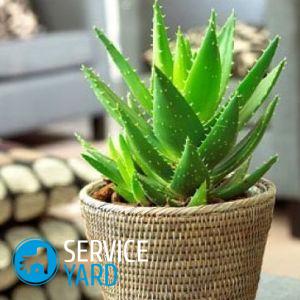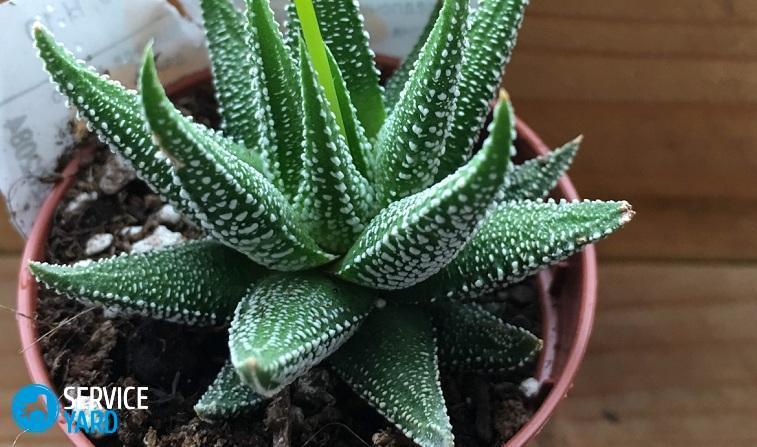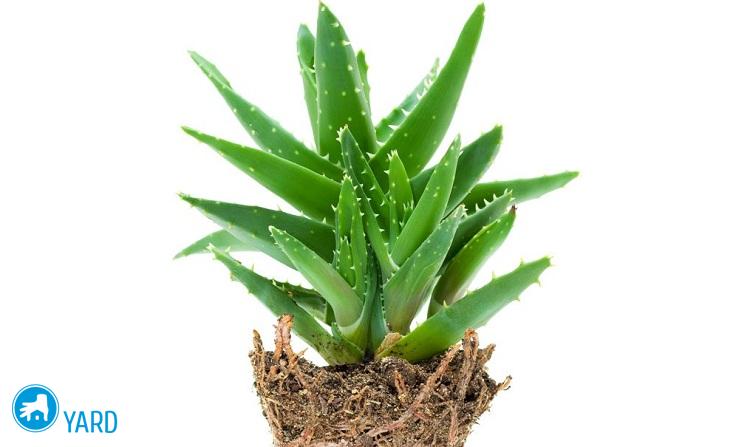How to care for aloe at home?

The perennial aloe plant is a pet for many of us. In addition to its attractive appearance, this plant also has a lot of useful healing properties. It is widely used in folk medicine for the preparation of various ointments and creams, aloe juice is especially useful. A houseplant is quite unpretentious, resistant to many diseases and pests, but in order for the flower to please its appearance and possess the maximum amount of healing substances, you need to know how to care for aloe at home. Today we will talk about the rules for caring for a decorative plant and introduce you to some of the features of this wonderful flower.
to contents ↑Aloe as a separate culture
Aloe vera is a succulent shrub belonging to the Lilac family. In natural nature, the plant grows in the arid regions of Africa (Madagascar, Mozambique, Zimbabwe).
Important! Succulent is so undemanding to soil that it grows even on volcanic ash. The plant is bred on special plantations in certain conditions and used for medicinal purposes.
Tropical perennial plant has large elongated succulent leaves, collected in a rosette, and containing sharp spikes at the edges. Unfortunately, succulent blooms only in the wild (2-3 times a year). Its flowers grow large, have a yellow, red or orange hue, depending on the species. At room content, the plant blooms very rarely - once every 10, or even 20 years. The flowers of such a plant are inconspicuous, small, and it is recommended to immediately cut off the arrow with a peduncle.
to contents ↑Important! Today, about 350 varieties of succulents are known, however, not all of them can be grown at home.
Types of aloe
The most common indoor varieties of aloe are as follows:
- Treelike (agave). In height, such a flower can reach 1 meter.
- Aloe vera or real aloe is a large plant with rosettes. This type of succulent has several varieties: medicinal, ordinary, yellow, Barbados. All these plants are widely used in cosmetology.
- Variegated or brindle. Decorative low flower has a beautiful appearance and a short stem. If the care for aloe at home is organized correctly, then the plant will have flowers.
- Folded.
- Spinous. The plant has a very beautiful appearance, but recently it can rarely be found in homes.
The healing properties of aloe
Indoor aloe has the same healing properties as all of its “brothers.” In folk medicine, not only juice is used, but also aloe pulp, thanks to the following medicinal substances contained in the plant:
- Anthraquinones - have analgesic properties.
- Atzemannana - increases the effect of chemotherapy.
- A huge number of antifungal elements - help in the treatment of skin diseases.
- Ulcin - promotes the healing of ulcers on the mucous membrane.
If we talk about the healing properties of succulents, they are as follows:
- Aloe can heal wounds and abrasions, relieve itching and swelling, and heal burns.
- Accelerates the healing of postoperative sutures.
- Reduces blood sugar.
- Lowers temperature.
- Increases immunity.
- Acts as an antioxidant.
- Destroys intestinal and dysenteric sticks.
- Helps tissue repair during frostbite.
- Normalizes bowel function.
- Stabilizes all body systems.
Important! For medicinal purposes, aloe is used only when it is already more than three years old.
In order for a houseplant to possess all of the above medicinal properties, you need to know how to care for aloe. This will be discussed below.
to contents ↑Rules for boarding and transplanting
For all types of succulents, there are general principles of cultivation, but some varieties have their own characteristics, which must be considered in order to properly care for them.
Priming
The main aspect of growing plants at home is the right soil.
The soil for succulents must meet the following requirements:
- Fertility.
- Friability.
- Permeability to air.
Important! Many flower growers acquire soil in a specialized flower shop, however, it must be remembered that the land must be specially selected for succulent.
It is best to prepare the soil mixture yourself by mixing the following components:
- Sand (1 part).
- Soddy clay soil (2 parts).
- Leaf soil (1 part).
Important! In order for the soil to become looser and lighter, you need to add charcoal or crushed brick. You can add 1 part of humus to the soil.
Capacity for landing
Succulent planting is best done in a spacious and large pot. This is due to the fact that aloe varieties form a fairly extensive root system, which is able to grow intensively. If the roots do not have enough space in the pot, then they will crawl out, while the lower leaves can completely dry out. Plant a plant in a new pot periodically as it grows.
Important! Aloe vera should be grown only in a ceramic pot, since only clay can absorb excess moisture.
Landing rules
To properly plant a plant in a pot, perform the following operations:
- Put drainage at the bottom of the new pot to prevent stagnation of moisture. Expanded clay or broken brick can act as drainage.
- Put a little soil on top of the drain.
- Gently plant the plant in a pot. If you are replanting succulent from an old pot into a new one, then carefully remove it, clean the roots from the soil and examine them for rot. If rotten roots are found, be sure to cut them off. Also trim the blackened and dried roots. Damaged roots during transplantation should also be removed.
- Fix the plant in a pot by pressing several pebbles to the base of the flower.
- Sprinkle aloe on the ground.
- Compact the ground and sprinkle 1-2 cm of dry soil on top.
Advice:
- To keep the soil in the pot nutritious, carry out additional dressings during the period of active flower growth. Use fertilizers in April-September. As a top dressing, use complex mineral fertilizers. Feed every month, and then take a break until next spring.
- Transplant the plant as necessary. Transplant adult flowers 1 time in 3-4 years, and young flowers - 1 time in 2 years.
Important! Transplant in the spring, since this particular period of the year is considered an excellent time for reproduction.
- When replanting a new pot, choose 20% more than the old one.
- In the process of transplanting, you can get excellent planting material. Shoots growing from the mother's root, carefully tear off and plant in the ground. Water abundantly. Further care for aloe at home is no different from caring for an adult plant.
- The easiest way to propagate a plant is to cut the apical cuttings. Separate whole leaves can also be used for propagation. Planting material depends on the type of plant.
Lighting and air temperature requirements
Succulent is a photophilous flower, therefore it is better to contain it on the southern or eastern windows.The plant is not afraid of sunlight, given the conditions under which aloe grows in the wild. In summer, it is recommended to equip aloe on an open balcony or in the garden so that it takes sun baths and receives an additional dose of ultraviolet radiation, which is not enough because of the window panes.
Important! After summer sunbathing, the plant will have a more powerful stem and thick long leaves. And vice versa - with insufficient lighting, the leaves of the plant begin to turn pale and stretch into long stems.
As for temperature, in summer it should be + 22-26 degrees, and in winter - not lower than +10 degrees.
Important! The minimum possible temperature for a succulent is +5 degrees.
Advice:
- The spring sun after the winter cold becomes hot for plants, so the flowers must be shaded so that they do not get burns. To do this, use gauze or tulle, filtering bright sunlight. Accustom yourself to the sun gradually, carry out the shading procedure for a week.
- Since there is a dormant period in winter, place it in a cooler place with a temperature of about +14 degrees. Lack of light at elevated temperatures can cause the leaves to stretch.
- In winter, it is better to illuminate the flower with artificial light, although even without it it is able to tolerate shading well.
How to water aloe?
Aloe does not need frequent watering:
- The plant should be watered only when the upper earthen layer in the pot dries.
- Water should be poured as much as necessary to moisten the soil, but not more.
- Watering can be done both from above and into the pan.
- Water for irrigation should be settled and have room temperature.
Important! In the spring-summer period, the flower requires more moisture, so water 2-3 times a week. In winter, reduce watering to once every two weeks, because during dormancy the flower does not need excessive moisture.
Advice:
- It is better to water the flower in a pan, since it is there that the root system absorbs moisture. Half an hour after watering, be sure to drain the remaining water from the pan so that the roots do not rot from excessive moisture.
- You do not need to spray aloe in the summer, you can only wipe the leaves from dust with a damp cloth.
- During cold wintering, the temperature of water for irrigation should be 10 degrees higher than air temperature.
- Water the plant so that water does not get into the outlet with leaves, as this can lead to rotting of the trunk.
- If you want to achieve flowering aloe, then arrange for him a period of rest in winter. To do this, the temperature should be lowered and the daylight extended, which is provided by artificial lighting.
to contents ↑Important! We warn you right away that it is quite difficult to provide such conditions, therefore it is almost impossible to achieve flowering from a plant at home, but still, you can try.
Pest and Disease Control
If you properly organized care for aloe vera at home, then he will not be afraid of insect pests and pathogenic microorganisms. Aloe is little susceptible to disease and insects practically do not attack it. But if caring for a plant is systematically disrupted, then problems such as root and dry rot can appear.
Excess moisture
The most common cause of succulent disease is excess moisture. If the flower is damaged by root rot, the plant becomes sluggish, the leaves stop growing and gradually dry out at the base.
To solve the problem and cure the plant, proceed as follows:
- Remove all affected areas.
- Sprinkle with charcoal.
- Plant the plant in a clean pot with the new mixture.
- Start watering no sooner than after three weeks.
Important! With a large damage by root rot, the flower is better to throw out with the pot, since microorganisms can live in the pores of ceramics for many years.
Poor water for irrigation can also lead to illness.If it is too stiff, then the leaves will dry out, starting at the tips.
Dry rot
A more insidious disease is dry rot, since it does not manifest itself externally for a long time - the plant simply dries from the inside. Unfortunately, very often in such cases the plant cannot be saved.
Pests
Of the pests that most often affect succulents, the following species can be distinguished:
- Shield. This is one of the most common misfortunes. You can detect pests on the back of the leaves (in the form of brown spots). You can remove pests with a sponge moistened with alcohol. You can wash the leaves with a mild soap solution.
- Spider mite. This pest is very difficult to detect, since it has a very small size. If a spider mite is found, we recommend that the plant be exposed to fresh air and ventilated more often. Use a succulent insecticide to control the tick.
Such a mealybug and thrips also affect such a plant. To rid the flower of pests, use insecticides. For each type of insect, it is necessary to use a specific preparation.
to contents ↑Stock footage
We hope that our information has helped you learn how to care for aloe vera at home. If you follow all our tips and tricks, organize the care of your “home doctor” correctly, then the plant will live for several decades, giving your home health and well-being!
- How to choose a vacuum cleaner taking into account the characteristics of the house and coatings?
- What to look for when choosing a water delivery
- How to quickly create comfort at home - tips for housewives
- How to choose the perfect TV - useful tips
- What to look for when choosing blinds
- What should be running shoes?
- What useful things can you buy in a hardware store
- Iphone 11 pro max review
- Than iPhone is better than Android smartphones





